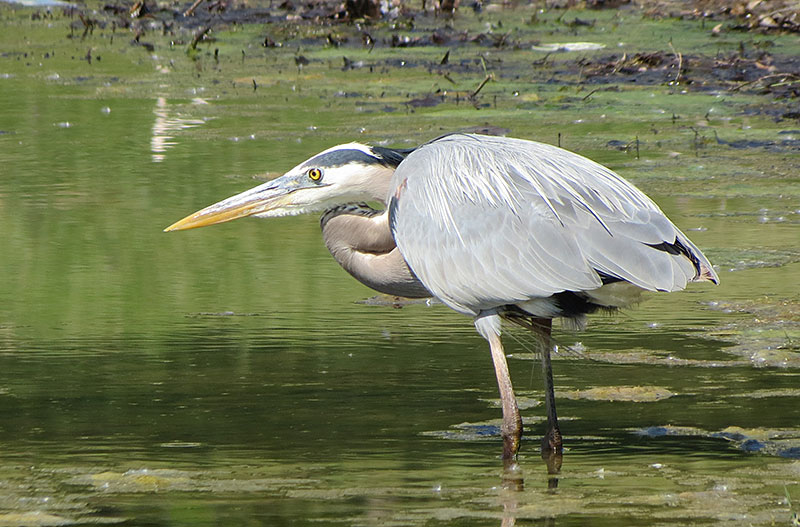The Great Blue Heron is the largest heron in North America. They have daggerlike bills, long legs, and curved necks. They generally appear shaggy overall in appearance.
In this habitat, you’ll more than likely see these birds standing entirely still, tracking the movements of frogs and fish. They’re waiting for the perfect moment to strike.
However, they will also happily feed in rivers and backyard ponds in urban areas. Be careful if trying to approach because this usually startles them, causing them to fly away.
On this page
Identification
Adult male and adult female Great Blue Herons look identical.
Great Blue Herons have white heads with a black stripe on each side extending from their yellow eyes to slender black plumes at the back of the head. Their chests are white striped with black, and their backs are greyish blue. Breeding Great Blue Herons have long plumes on their backs, flanks, and breasts.
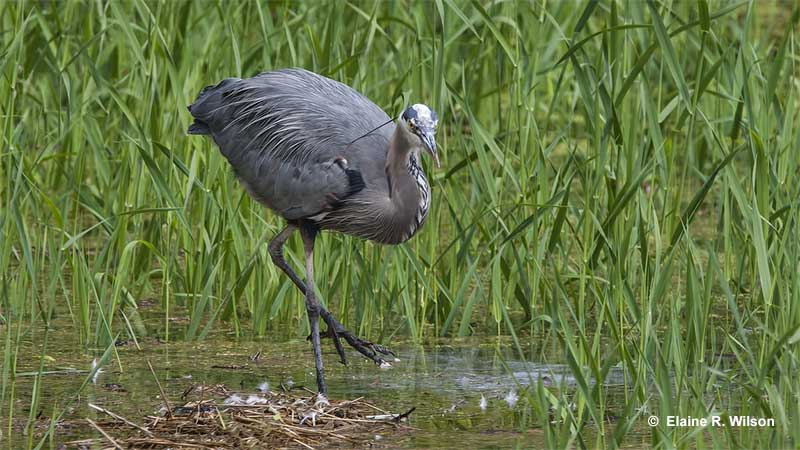
Immature Great Blue Herons are grayish-blue overall and have pale bellies. Additionally, they have brownish feathers mixed throughout and dark streaking on the neck.
These birds are 38 to 54 inches long, weigh 74 to 88 ounces, and have a wingspan of 65 to 79 inches.
Food
Great Blue Herons primarily consume insects, fish, reptiles, small mammals, and amphibians.
These birds forage by walking very slowly or standing completely still in shallow water. They’ll wait for their prey to swim by, then strike with a quick thrust of their bill. They’ll forage on shore, from floating objects, and in grassland. They’ve been seen hunting both day and night.
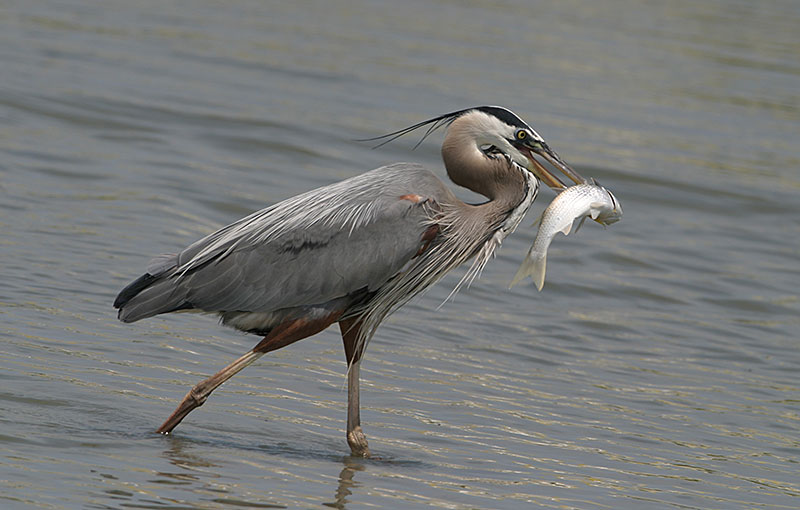
These birds usually forage for food alone but can sometimes be seen feeding with other water birds.
Nesting and Eggs
The primary nesting sites for Great Blue Herons are trees; however, they are also known to make nests on the ground, mangroves, bushes, and artificial structures like artificial nest platforms, channel markers, and duck blinds.
Upon arriving at the colony, male Great Blue Herons select and settle into specific nest locations, where they proceed to court females. These colonies can be significant in size, containing 500 or more individual nests. There are often several nests per tree, positioned at 100 feet or more above the ground.
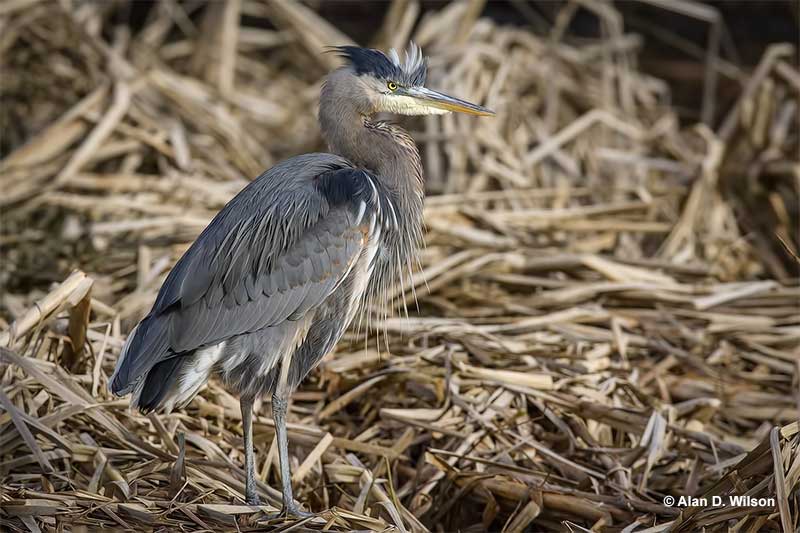
Male Great Blue Herons are the ones to collect the majority of nesting materials required for construction. They gather sticks from trees, nearby shrubs, and the ground.
They also use unattended or abandoned nests, presenting these collected materials to the female. The female will then skillfully weave the materials into a platform and a saucer-shaped nest cup.
The female Great Blue Heron lines the nest with small twigs, pine needles, mangrove leaves, moss, dry grass, or reeds to provide further insulation and comfort.
The process of making these nests can span anywhere from 3 days to 2 weeks. The final structures exhibit a range of complexity, from simple 20-inch-wide platforms to more intricate formations, which may span up to 4 feet across and have a depth of nearly 3.5 feet.
Great Blue Herons usually have one to two broods per breeding season, each clutch ranging from 2 to 6 eggs. The eggs are pale blue in color, and their color fades slightly.
Great Blue Herons incubate the eggs for around 28 days, after which the young herons stay in the nest for up to 80 days.
Current Situation
According to the ICUN Red List, the Great Blue Heron is a species of low concern. There are estimated to be up to 5 million specimens.
However, there has been a significant decrease in population in specific regions, particularly noticeable within the “great white heron” population in southern Florida. This decline could be partly due to the heightened mercury levels found in local water systems.
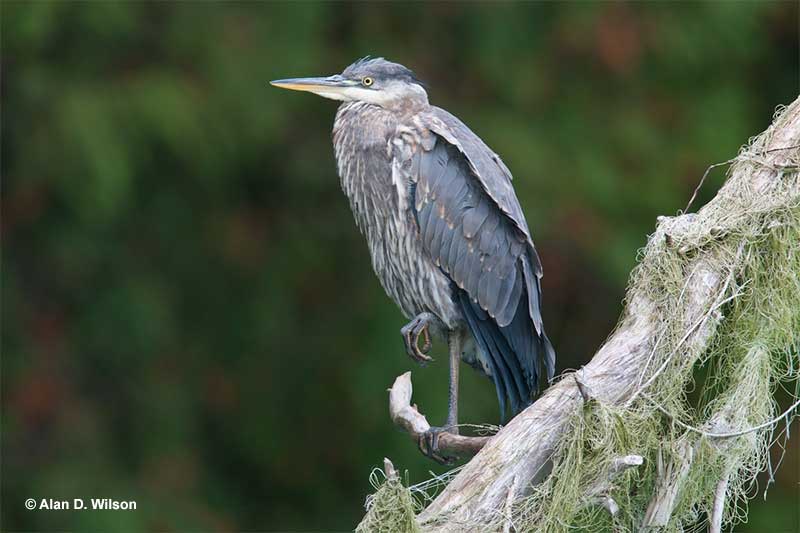
Great Blue Herons maintain a presence across North America throughout the year.
Due to their reliance on wetlands for food and the necessity for undisturbed locations for breeding, they remain susceptible to losing their habitats caused by human activities. Disturbances like boats, logging, traffic, and other human activities can potentially disrupt their nesting colonies.
Additionally, the threat posed by chemical contaminants and other factors leading to compromised water quality cannot be overlooked.
While pollutant levels have decreased in various regions, substances such as PCBs, DDT, and emerging industrial compounds persist in impacting heron habitats. These factors can diminish the attendance of these birds at nesting sites.
Facts
- During the breeding months, Great Blue Herons’ lore will turn bright blue, the iris will turn reddish, and the yellow bill will have an orange hue.
- Great Blue Herons keep cool in hot weather by drooping their wings and opening their beak. You may also see them fluttering their throat muscles to promote evaporation. This is called “gular fluttering.” The drooped wings allow air to flow and help remove excess heat.
- Great Blue Herons look very large in flight; they have a six-foot wingspan.
- These birds can consume up to 2 pounds of fish a day.
- Great Blue Herons can live up to 25 years.
Similar Species
Great Blue Herons have features that are similar to other bird species. Here are some similar species:
Little Blue Heron
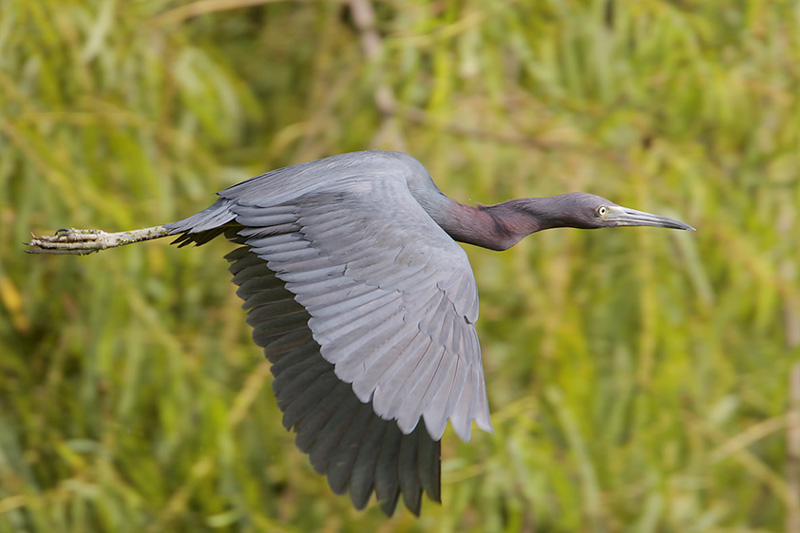
Great Blue Herons are much larger than Little Blue Herons. Additionally, they have dark crowns and yellow bills that Little Blue Herons do not.
Tricolored Heron
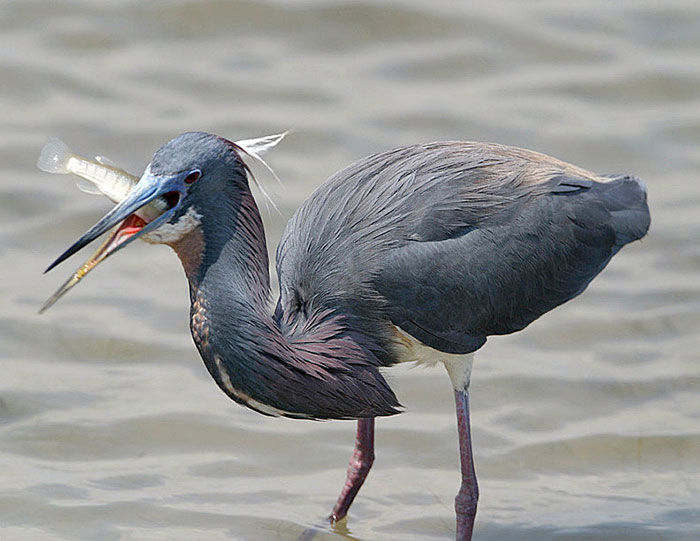
Great Blue Herons are larger than Tricolored Herons. Great Blue Herons have a lighter blue neck and lack the white line down the neck that Tricolored Herons have.
Sandhill Crane
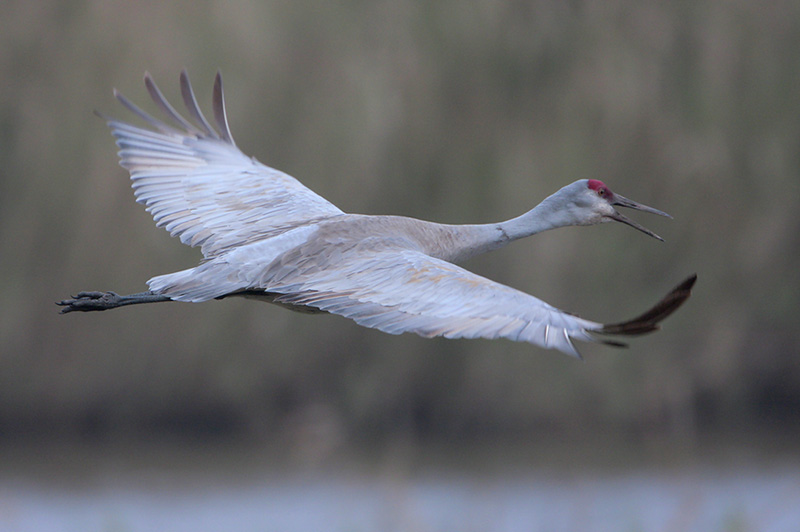
Great Blue Herons are less uniform than Sandhill Cranes. Sandhill Cranes are gray overall and have a vivid red crown that Great Blue Herons don’t have.
Additionally, Great Blue Herons keep their necks tucked in in flight, while Sandhill Cranes keep their necks outstretched.
Frequently Asked Questions
What is the difference between a Blue Heron and a Great Blue Heron?
Blue Herons and Great Blue Herons vary in size significantly. Blue Herons are smaller and lack the dark crowns and yellow bills that Great Blue Herons have.
Where do Great Blue Herons live?
Great Blue Herons can be found in a variety of marine and freshwater habitats, including wetlands, lakes, irrigation ditches, ponds, meadows, rivers, and flooded farmlands. For nesting, they require tall trees, such as are found in wooded swamps.
Do Great Blue Herons nest in trees or on the ground?
Great Blue Herons have been seen nesting both in trees and on the ground.
What is unique about the Great Blue Heron?
Great Blue Herons have special feathers on their chest that continue to grow and fray. They’ll use the fringed claws on their middle toes to fray the feathers even more to create a powder. They use this powder to remove oils like fish slime from their feathers when they preen.
Is it good luck to see a Great Blue Heron?
Yes, it is good luck to see a Great Blue Heron. Herons symbolize good luck and prosperity, particularly for the tribes of the west coast of the United States because they’re associated with plentiful fishing.

